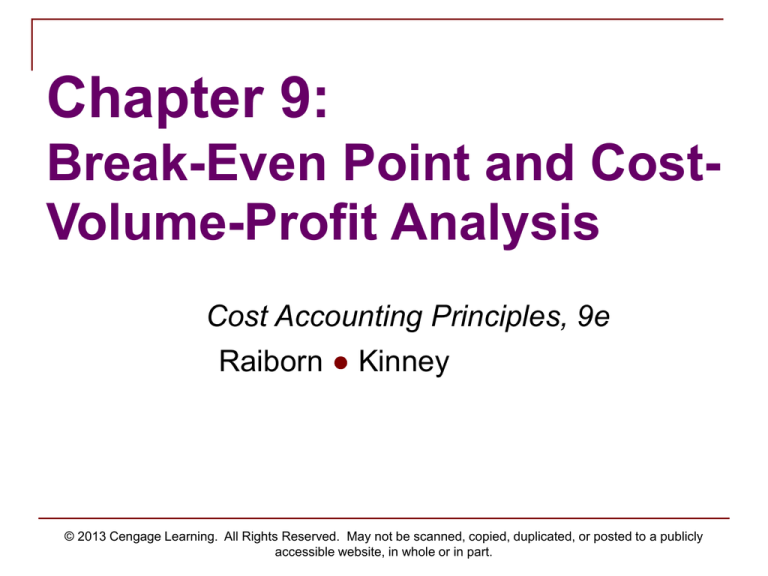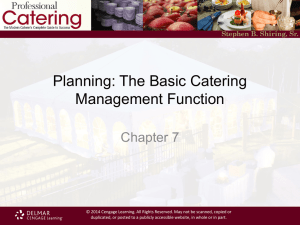
Chapter 9:
Break-Even Point and CostVolume-Profit Analysis
Cost Accounting Principles, 9e
Raiborn ● Kinney
© 2013 Cengage Learning. All Rights Reserved. May not be scanned, copied, duplicated, or posted to a publicly
accessible website, in whole or in part.
Learning Objectives
What is the break-even point (BEP) and why is it
important?
How is the BEP determined and what methods are used
to determine BEP?
What is cost-volume-profit (CVP) analysis and how do
companies use CVP information in decision making?
How do break-even and CVP analysis differ for singleproduct and multiproduct firms?
How are margin of safety and operating leverage
concepts used in business?
What are the underlying assumptions of CVP analysis?
© 2013 Cengage Learning. All Rights Reserved. May not be scanned, copied, duplicated, or posted to a publicly
accessible website, in whole or in part.
Variable Costing and Cost-Volume
Profit Analysis (CVP)
Variable costing
Separates costs into fixed and variable
components
Shows fixed costs in lump-sum amounts, not on
a per-unit basis
Does not allow for deferral/release of fixed
costs from/to inventory when production and
sales volumes differ
© 2013 Cengage Learning. All Rights Reserved. May not be scanned, copied, duplicated, or posted to a publicly
accessible website, in whole or in part.
CVP Assumptions
Company is operating within the relevant
range
Revenue per unit remains constant
Variable costs per unit remain constant
Total fixed costs remain constant
Mixed costs are separated into variable and
fixed elements
© 2013 Cengage Learning. All Rights Reserved. May not be scanned, copied, duplicated, or posted to a publicly
accessible website, in whole or in part.
Equations
Break-even point
Total Revenues = Total Costs
Total Revenues – Total Costs = Zero Profit
© 2013 Cengage Learning. All Rights Reserved. May not be scanned, copied, duplicated, or posted to a publicly
accessible website, in whole or in part.
Equations
Contribution Margin (CM)
Sales Price per Unit – Variable Cost per Unit = CM per Unit
Revenue – Total Variable Costs = CM in Total
Contribution Margin Ratio (CM%)
Sales Price – Variable Cost per Unit
Sales Price
© 2013 Cengage Learning. All Rights Reserved. May not be scanned, copied, duplicated, or posted to a publicly
accessible website, in whole or in part.
Traditional CVP Graph
Total Revenues
BEP
Total Costs
Total
$
Profit
Loss
Activity Level
© 2013 Cengage Learning. All Rights Reserved. May not be scanned, copied, duplicated, or posted to a publicly
accessible website, in whole or in part.
Profit-Volume Graph
$
BEP
Activity Level
Fixed Costs
Loss
Profit
© 2013 Cengage Learning. All Rights Reserved. May not be scanned, copied, duplicated, or posted to a publicly
accessible website, in whole or in part.
Income Statement Approach
Sales
Less Total variable costs
Contribution margin
Less Total fixed costs
Profit before taxes
Income taxes
Profit after taxes
B/E
$ 150,000
(50,000)
$ 100,000
(100,000)
-0-
Target Profit
$ 240,000
(80,000)
$ 160,000
(100,000)
60,000
(24,000)
$ 36,000
Proof of CVP and/or graph solutions
© 2013 Cengage Learning. All Rights Reserved. May not be scanned, copied, duplicated, or posted to a publicly
accessible website, in whole or in part.
Incremental Analysis
Focuses only on factors that change from
one option to another
Changes in revenues, costs, and/or volume
Break-even point increases when
fixed costs increase
sales price decreases
variable costs increase
© 2013 Cengage Learning. All Rights Reserved. May not be scanned, copied, duplicated, or posted to a publicly
accessible website, in whole or in part.
Multiproduct Cost-Volume-Profit
Analysis
Assumes a constant product sales mix
Contribution margin is weighted on the
quantities of each product included in the
“bag” of products
Contribution margin of the product making up
the largest proportion of the bag has the
greatest impact on the average contribution
margin of the product mix
© 2013 Cengage Learning. All Rights Reserved. May not be scanned, copied, duplicated, or posted to a publicly
accessible website, in whole or in part.
Multiproduct Cost-Volume-Profit
Analysis
Sales mix
3
2
Contribution
margin per unit
$2
$1
Breakeven
$8,000 (fixed cost)
3($2) + 2($1) = 1,000 “bags”
© 2013 Cengage Learning. All Rights Reserved. May not be scanned, copied, duplicated, or posted to a publicly
accessible website, in whole or in part.
Multiproduct Cost-Volume-Profit
Analysis
Sales mix
3
Breakeven “bag” x 1,000
Breakeven units
3,000
2
x 1,000
2,000
To break even sell 3,000 units of first product
and 2,000 units of second product
© 2013 Cengage Learning. All Rights Reserved. May not be scanned, copied, duplicated, or posted to a publicly
accessible website, in whole or in part.
Margin of Safety
How far the company is operating from its
break-even point
Budgeted (or actual) sales after the breakeven point
The amount that sales can drop before
reaching the break-even point
Measure of the amount of “cushion” against
losses
Indication of risk
© 2013 Cengage Learning. All Rights Reserved. May not be scanned, copied, duplicated, or posted to a publicly
accessible website, in whole or in part.
Margin of Safety
Units
Actual units - break-even units
Dollars
Actual sales dollars - break-even sales dollars
Percentage
Margin of Safety in units or dollars
Actual unit sales or dollar sales
© 2013 Cengage Learning. All Rights Reserved. May not be scanned, copied, duplicated, or posted to a publicly
accessible website, in whole or in part.
Operating Leverage
Relationship between variable and fixed costs
Effect on profits when volume changes
Cost structure strongly influences the impact that a change in
volume has on profits
High Operating Leverage
Low variable costs
High fixed costs
High contribution margin
High break-even point
Sales after break-even have
greater impact on profits
Low Operating Leverage
High variable costs
Low fixed costs
Low contribution margin
Low break-even point
Sales after break-even have
lesser impact on profits
© 2013 Cengage Learning. All Rights Reserved. May not be scanned, copied, duplicated, or posted to a publicly
accessible website, in whole or in part.
Cost-Volume-Profit Assumptions
Company is operating within the relevant
range
Revenue and variable costs per unit are
constant
Total contribution margin increases
proportionally with increases in unit sales
Total fixed costs remain constant
Mixed costs are separated into variable and
fixed elements
© 2013 Cengage Learning. All Rights Reserved. May not be scanned, copied, duplicated, or posted to a publicly
accessible website, in whole or in part.
Cost-Volume-Profit Assumptions
No change in inventory (production equals
sales)
No change in capacity
Sales mix remains constant
Anticipated price level changes included in
formulas
Labor productivity, production technology,
and market conditions remain constant
© 2013 Cengage Learning. All Rights Reserved. May not be scanned, copied, duplicated, or posted to a publicly
accessible website, in whole or in part.
Questions
What is the break-even point, and why is it so
important?
How do companies use cost-volume-profit
analysis?
How are margin of safety and operating
leverage concepts used in business?
What are the underlying assumptions of costvolume-profit analysis?
© 2013 Cengage Learning. All Rights Reserved. May not be scanned, copied, duplicated, or posted to a publicly
accessible website, in whole or in part.
Potential Ethical Issues
Ignoring relevant range in setting assumptions about
cost behavior
Using absorption (fixed manufacturing) costs as part of
variable costs for CVP analysis
Using improper assumptions about cost and volume
relationships
Assuming constant sales mix while ignoring demand for
individual products
Using CVP analysis to improperly support long-term cost
management strategies
Visually distorting break-even graphs
Using irrelevant information in incremental analysis to
manipulate results
© 2013 Cengage Learning. All Rights Reserved. May not be scanned, copied, duplicated, or posted to a publicly
accessible website, in whole or in part.








